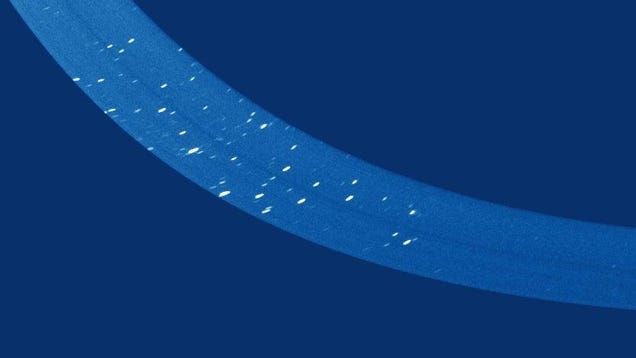The JUICE spacecraft captured its first ultraviolet views of the cosmos, revealing a beautiful streak of the Milky Way littered with shining stars from the southern sky. It’s not the most spectacular image, but it signals operational progress.
JUICE’s Ultraviolet Spectrograph (UVS) instrument recently sprung into action, collecting its first set of data that was later imaged by the mission team. “On June 20, we opened the UVS aperture door to collect UV light from space for the first time,” Randy Gladstone, JUICE-UVS principal investigator, said in a statement. “Soon after, we observed a swath of the sky to verify the instrument was performing well.”

The imaged data reveals a swath of the southern sky, a region of the Milky Way near the southern constellation Carina, shown on the left. Those bright, glittering specks are bright stars in our galaxy while the cloud-like structure on the bottom right of the image is a nearby galaxy called the Large Magellanic Cloud.
The European Space Agency’s JUICE mission is currently on its way to Jupiter to study three of Jupiter’s icy moons: Europa, Ganymede, and Callisto. The three Gallilean moons are suspected of harboring subsurface oceans and potentially habitable conditions beneath their icy surface.
JUICE’s UVS instrument was developed by the Southwest Research Institute (SwRI) in San Antonio, Texas, and is one of three JUICE instruments contributed to the mission by NASA. The instrument captures data in ultraviolet wavelengths of light, which are not visible to the human eye.
The ultraviolet light meter is about as big as a microwave, weighing around 40 pounds (18 kilograms) and drawing only 7.5 watts of power, according to SwRI. As one of 10 science instruments on board JUICE, UVS is designed to measure the concentrations of different elements and molecules in the atmospheres of Jupiter’s moons by recording the ultraviolet light that is reflected by the Jovian system.
JUpiter ICy moons Explorer, or JUICE for short, launched on April 14 and is expected to reach the Jovian system in 2031. During its eight year journey to Jupiter, the team behind the mission is working to deploy and activate JUICE’s various antennas, booms, sensors and instruments. The spacecraft’s magnetometer boom (J-MAG) was deployed on April 21, collecting a blip of its surrounding magnetic field.
We can’t wait to see what other exciting data the Jupiter probe will capture next as it prepares itself for the Jovian system.
